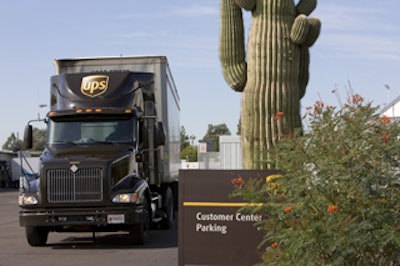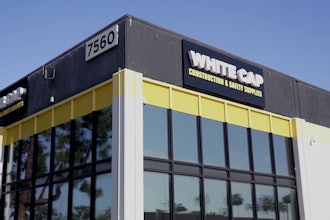
In April 2012, UPS announced the new UPS CrossBorder Connect service, a ground freight service providing another cost and speed option for cross-border shipments with fast and reliable transit times between most major U.S. cities and Mexico. Industrial Distribution spoke with Matt Hanna, industrial manufacturing marketing manager at UPS, about the new service and how it relates to trends toward near-sourcing in the industrial distribution markets.
What issue, gap in coverage, or recurring pattern did you see that prompted this specific solution?
We took note of the growth in trade between the US and Mexico, specifically between 2008 and 2011. During that period of time, total trade increased by 21% based on US Census trade data with imports increasing 17.5%. This is a tremendous growth in trade. This growth has led the percent of imports from Mexico to increase from 10.3% in 2008 to 11.9% in 2011. Also, we looked at the logistics capabilities available to facilitate this trade between Mexico and the US and identified a general lack of lift capacity in the air network out of Mexico. This shortage of air capacity has had the expected impact of raising prices and reducing delivery reliability, with some shipments being unable to fly on the expected day. When you are counting on that shipment of goods to be delivered to you so that you can continue your operations, or in the case of the distributor, to actually move goods cross-dock to actually fulfill orders, delay is unacceptable. This increasing cost and risk of delay is what made us ask if there was another way to move expedited goods from Mexico to the United States, and do so without incurring this limited capacity of the air network, and quite honestly we found it with the UPS Cross Border Connect service.
Your press release concerning the service claims that it will “boost speed to market, drive cost efficiencies and reduce supply chain risk”: How is it fulfilling those claims?
I think one of the key points to talk about is how the good actually moves. With this service we are doing a consolidated clearance: we are clearing it through brokerage at the point of origin and then we are able to move that entire shipment through customs at the border incredibly quicker than we would otherwise. We’re talking about cutting out days in the time of transit because we are actually able to go through the border crossing much faster than people who are trying to clear directly at the border crossing. With that, we are able to move that good and are able to move it for example, to points in the Midwest faster than anyone who is currently moving goods using LTL or truckload shipping, The Cross Border Connect service also moves goods at a more affordable rate than current air freight rates. So, the use of the service allows you to move goods faster than other current ground movements and to do this at a price that is below current air freight rates.
So the claim about reducing supply chain risk: how is it doing that?
The risk that we are referencing here is really that unacceptable risk of delay. If you were to get held at the border for two to three days, but you needed that specific good within three days, with that two-three day delivery delay, suddenly you are looking at six days for final delivery of the product: twice the time. That would have a tremendous impact on your ability to either run your operation or to fulfill your customers’ orders.
How would you describe “near-sourcing” – what kind of an impact is it having on suppliers and distributors? Is it a new trend, and if so, why do you see it happening?
As a global company we think of near sourcing on a global basis and define it as sourcing nearer to the ultimate consumption of the good. In the case of the US, this means sourcing from the US, Mexico, Canada or Central/South America, but can also be used to reference manufacturing in China for consumption in China
Trend-wise we are seeing a change in the calculation that companies use to determine what items they will near source. Previously, if you were evaluating which products to manufacture in the US, you would look at the level of innovation or customization that was needed for the product, and the importance of speed –to-market and if the product was not highly customized and speed to market was not an issue, these products would be considered for international sourcing because of the perceived lower cost of production.
Today, those two components are still part of the calculation, but now companies are looking at a number of other things, one being rising oil prices which impact on transportation costs. Another factor is the time that it takes to move these goods to their destination point. Add to that the increase in international wages. In China, wages are up 19% from 2005-2010 and are forecast to go up another 17% from 2010 to 2015, so that starts to change the total cost calculation. Another really important component that a lot of people lose sight of is the cash flow impact of purchasing internationally versus domestically. When you look at international sourcing, the typical engagement is to pay for the good up front, prior to production, which means that your cash-to-cash cycle includes the entire production timeline, the shipping timeline, the storage period all the way up to the final delivery to your customer. Contrast that to domestic sourcing: you don’t have to pay until you receive the good. We’re talking 6-10 weeks and sometimes even further out for a cash turnaround on international sourcing. As more customers get more familiar with these types of calculations and refine their total landed cost, they are getting more comfortable recommending near sourcing.
Do you see this program being a primarily time-saving strategy, keeping customers happier with shorter lead times, or will it also be cost-efficient in the long run?
It’s both. There is the cost savings component: if you are currently an air-freight user, this will save you money without a significant slowdown in the delivery of your goods. If you are currently a traditional ground freight user, and need your goods to move faster, but cannot pay air freight rates, this is a perfect product for you. That time savings can translate into dollar savings. Typically where we would see the greatest impact to that is in their inventory carrying cost. You absolutely have the opportunity with a product like UPS Cross Border Connect to bring in larger quantities faster than you do today, and in so doing, you can downsize the total inventory that you carry on hand. Inventory on hand is not a money making proposition: it is a cost drag on companies and is usually the number one or number two operational cost for companies. We have found an area where we can improve our own operations through a unique product offering and we can pass that capability onto our customers so that they can continue to improve their own operations. It’s really logistics in action.


















